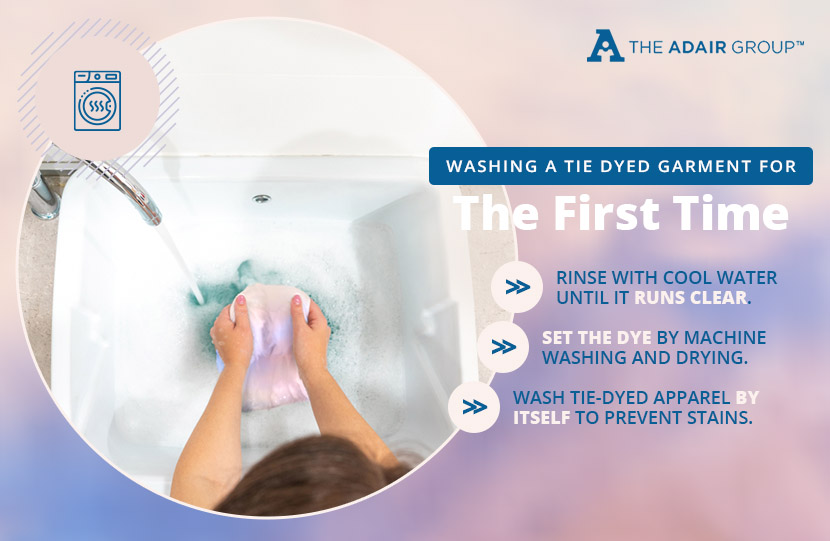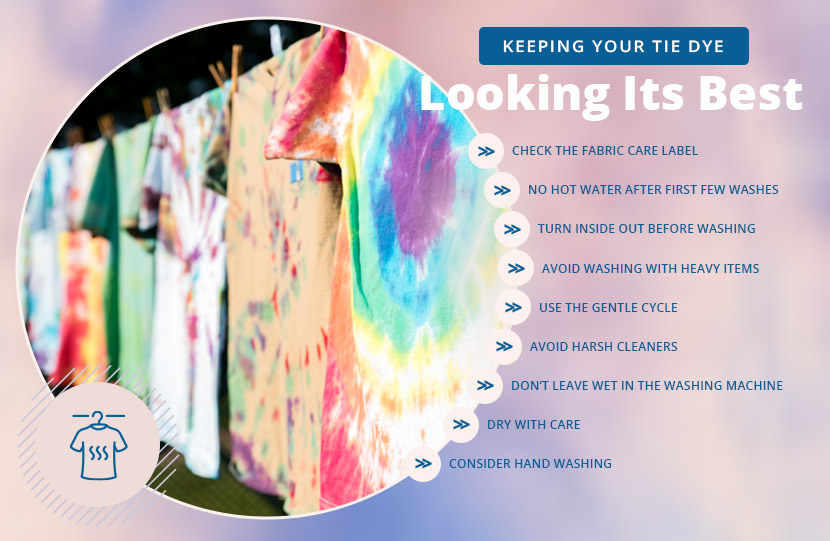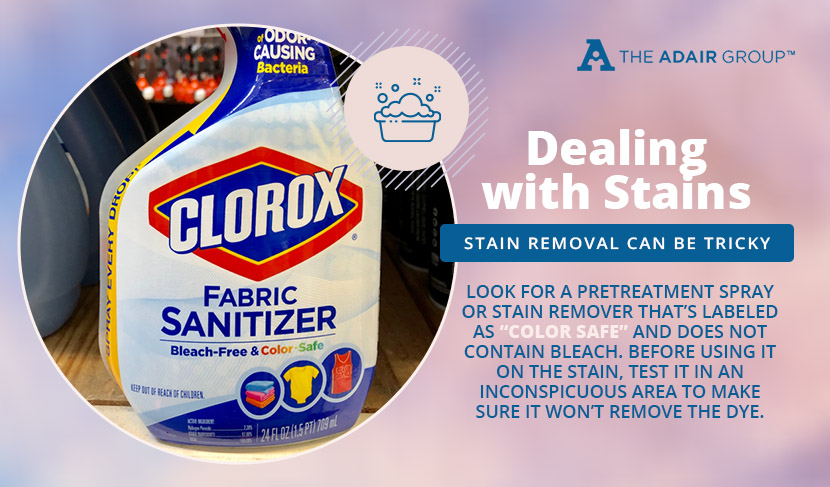How to Wash Tie Dye to Keep Colors Bright

So, you just finished tie-dyeing a one-of-a-kind piece of wearable art or received a tie-dyed shirt as a gift. Or maybe you dyed an entire batch of white t-shirts for tie-dye to resell. What next? Whatever the case may be, you obviously want to keep the color looking vibrant for as long as possible, but you might not be quite sure of exactly how to do that. By learning how to properly wash and care for your most colorful apparel, you can keep your tie-dyed gear looking brand new for years.
While tie-dyed garments require a bit more TLC than other clothing items, they are not particularly difficult to care for. You just need to be mindful of things that could cause fading and avoid them. Washing your brightest, most colorful clothing the same way you wash the rest of your wardrobe could be a recipe for disaster. It could fade, stain other clothing or just end up not looking as great as it once did.
We Have a Wide Selection of White T-Shirts for Tie Dye
Here at The Adair Group, we want to help you keep your custom clothing looking just as vibrant as it looked the first time you removed the rubber bands after tie-dyeing it. That is why we are sharing some of our top tips for keeping colors bright, so you or your customers can enjoy your favorite threads for as long as possible. Keep reading to learn how to wash tie dye to keep colors bright!
Getting Things Right the First Time: Washing a Tie Dyed Garment for the First Time

The Initial Rinse
Whether you dyed wholesale shirts yourself or picked up a tie-dyed tee or hoodie from a retailer, we recommend taking special care when washing it for the first time. You never know what process a manufacturer may have used, so it never hurts to take the same precautions when laundering your new garment as you would if you made it yourself. It’s always better to be overly cautious than to inadvertently damage an article of clothing due to carelessness.
When making your own tie dye, give the dye about 24 hours to set before rinsing. Once this time has elapsed, rinse with cool water until it runs clear. You can do this either in your sink or tub or outside with a garden hose. Just be mindful that the dye can stain your sink, countertop, floor, concrete patio, etc. — so be careful!
Next, carefully remove the strings or rubber bands as you continue rinsing under running water. Wring the garment out under the water and repeat until the water runs clear. Always use cool water for this part of the process. When finished, hang the garment to allow the excess water to drip off. Hanging the item outside is an excellent, mess-free option. Just be sure to avoid placing it in direct sunlight because this can cause fading.
If you purchased a pre-made tie-dyed shirt or hooded sweatshirt, we recommend following the steps outlined above (aside from removing the rubber bands/strings, of course). You may find that the water runs clear right away, or you may discover lots of excess dye to remove. Either way, pre-rinsing takes just a few moments and poses no risk of harming your apparel.
Setting the Dye in Your Washer and Dryer
Now that you have removed all of the excess dye, you want to make sure that any dye remaining in the fabric will stay where it is without fading. To do this, you need to set the dye by machine washing and drying.
Place your new garment in the washing machine either by itself or with other freshly dyed items with similar colors. No matter how well you rinsed in the previous step, the dye will run during the first laundry cycle. To avoid damaging your other clothing, never wash them with freshly dyed items.
Set the machine to the smallest load size if you are washing a single item. If you are washing multiple items, select the load setting most appropriate for the number of garments you need to wash. You may also want to choose a larger setting when setting dye on heavier clothing, like wholesale hoodies.
Add a small amount of your usual laundry detergent and select the hottest temperature setting. Hot water helps set the dye, so this is extremely important, even if you normally wash your clothes using cold water. Run a regular wash cycle and then place the garment(s) in the dryer. Dry using high heat.
You may need to repeat this washing/drying process a few times to completely set the dye. We encourage you to wash tie-dyed apparel by itself or with similarly colored garments for the first several washes to prevent stains. You can also wash vibrantly colored clothes with old tees, dish rags and other items that won’t be ruined if they get discolored.
Check Out Our Wholesale Hoodies!
Keeping Your Tie Dye Looking Its Best
You need to take care to prevent fading even after the dye has been set. Unfortunately, there just is not a foolproof means of setting the dye and ensuring that it never fades during regular washing. Instead, you need to follow certain guidelines to keep your t-shirt, hoodie, sweatpants, etc. bright and vibrant. Here are a few tips to keep your tie-dyed duds looking like new.

Check the Fabric Care Label
Garments made from 100 percent cotton are the best option when it comes to tie-dyeing. However, there are many other fabrics you could use. Before washing, always check the fabric care label. You may discover information to help you keep your specific garment looking its best.
Skip the Hot Water After the First Few Washes
During the first few washes, hot water helps set the dye to prevent fading. However, it is not the best long-term option when it comes to laundering your favorite clothes. Switch to cold water after those first few washes to prevent damage, fading and shrinkage. Avoid using high heat in your dryer, too. Ideally, you should hang tie-dyed tops and bottoms to dry once the dye is set.
Turn Tie Dyed Items Inside Out Before Washing
Do you normally turn your garments right side out before washing? You’ll want to skip this step when trying to keep colors bright. Washing your garments inside out helps prevent fading by reducing friction on the outside of the fabric.
Avoid Washing with Heavy Items
Friction in the wash is one of the leading causes of fading. When something like a soft t-shirt or tank top rubs up against heavier items like jeans and jackets, the resulting friction damages the fabric and often leads to fading. Even garments like hooded sweatshirts are more prone to fading when laundered with heavier, rougher fabrics. Buttons, zippers and snaps cause friction, too. For best results, wash all of your clothing with items that are similar in terms of weight and fabric composition.

Use the Gentle Cycle
Avoid as much wear and tear as possible to prevent fading. Using your machine’s gentle cycle or a short cycle minimizes friction and is less likely to cause fading. Use a gentle detergent, too. You want to remove dirt and debris from daily wear, not the dye.
Avoid Harsh Cleaners and Stain Removers
When you think about it, tie-dyeing is little more than a fancy way of staining your clothes. As a result, it doesn’t make sense to use harsh stain removers when you want to keep the intentional “staining” as vibrant as possible. Never use bleach, and be careful when using products to remove actual stains, like food spills, ink, etc. (We’ll discuss stain removal more below!) Also, skip the fabric softener. It isn’t a stain remover, but it can cause fabric damage. For this reason alone, it’s best to avoid using it with tie dye.
Don’t Leave Wet Clothing in the Washing Machine
If you normally start a load of laundry before heading to work and transfer it into the dryer upon your return home, you should avoid this method when caring for your tie-dyed apparel. Leaving a wet item in the washer for too long can cause color bleeding. And in addition to making the color fade, this could damage other items in your washer. Only wash your tie-dyed garments when you know you will be home to remove them from the washing machine right away.
Dry with Care
As mentioned above, air drying is the best option for tie-dyed clothing. When that is not possible, use your dryer’s low or medium-heat setting to minimize fading (as well as shrinkage). If you can air dry, you can do so either indoors or outdoors. Either way, be sure to avoid placing the item(s) in direct sunlight. The sun’s ultraviolet rays take a serious toll on dye and cause premature fading, so be sure to dry your clothes in a shady spot.
Consider Hand Washing
Do you have a special piece of tie-dyed apparel that you absolutely cannot risk ruining? If so, you may be better off hand washing it. Hand washing gives you more control over the process and is less likely to cause fading. It takes more time and effort, but it’s well worth it for those extra special garments.
To hand wash tie dye after the initial wash/dry, start by filling your sink or a tub with room temperature water. Add a mild, color-safe laundry detergent and then mix with your hands to create a nice bubble bath for your clothes. Submerge the garment and then gently agitate the water with your hands. Let soak for about 30 minutes and then rinse thoroughly to remove the soapy water.
Avoid wringing to dry. Instead, press the fabric against the sink or tub to squeeze out the excess water. Alternatively, lay the garment flat on a dry towel and then roll it up tightly to remove water. Either of these options will remove the excess water without causing damage like wringing might. Once the item is no longer dripping wet, hang or lay flat to dry.

Dealing with Stains
Stain removal can be a bit tricky with tie-dyed clothing. You want to get rid of the ugly stain, but you don’t want to fade the fabric surrounding it. To achieve this, you need to be extremely careful in terms of what type of stain remover you use. Look for a pretreatment spray or stain remover that’s labeled as “color safe” and does not contain bleach. Before using it on the stain, test it in an inconspicuous area to make sure it won’t remove the dye.
You may also want to consider using a natural stain remedy rather than a chemical-based remover. White vinegar does an excellent job of removing many stains, and it won’t damage tie-dye. Baking soda, salt and even meat tenderizer all make excellent stain removers, too. Do your homework to determine which products work best for the type of stain you are dealing with, and always test on an area that isn’t too noticeable before applying to a larger, more prominent area.
Closing Thoughts
Whether you dye bulk t-shirts to resell or give as gifts or you just love making tie-dyed apparel for yourself, knowing how to keep it clean is crucial. Sure, you could just throw it in the washing machine and launder it like you would your regular clothes. Unfortunately, doing so is a surefire way to cause some serious fading. To keep your garments looking their best, try the guidelines and suggestions above. With patience and proper care, the tie-dye shirt you just finished making will look just as incredible several years in the future as it does now!
Image Credits
David J. Mitchell/Shutterstock.com
Faizzamal/Shutterstock.com
Neuevector/Shutterstock.com
mariakray/Shutterstock.com
Blan-k/Shutterstock.com
New Africa/Shutterstock.com


